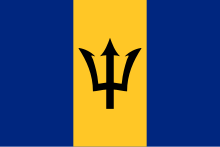Barbadians
 | |
| Regions with significant populations | |
|---|---|
| 65,653 (2013)[2] | |
| 37,780 (2016)[3] | |
| 18,762 (2011)[4] | |
| 1,147[5] | |
| 1,000[6] | |
| 483[7] | |
| Languages | |
| Bajan Creole, English | |
| Religion | |
| Predominantly Protestant, minority (3.4%) Roman Catholic, other religions include Islam, Judaism, Rastafari, Hinduism, Buddhism and Baha’i[8] | |
| Related ethnic groups | |
| Other Caribbean peoples (especially Afro-Caribbeans), Americo-Liberians | |
Barbadians, more commonly known as Bajans (pronounced /ˈbeɪdʒənz/ BAY-jənz), are people who are identified with the country of Barbados, by being citizens or their descendants in the Bajan diaspora. The connection may be residential, legal, historical or cultural. For most Bajans, several (or all) of those connections exist and are collectively the source of their identity. Bajans are a multi-ethnic and multicultural society of various ethnic, religious and national origins; therefore Bajans do not necessarily equate their ethnicity with their Bajan nationality.[9]
History
[edit]The earliest inhabitants of Barbados were indigenous Kalinago (Caribs) and Arawaks from South America. Between 1536 and 1550, Spanish raiders regularly seized large numbers of indigenous Taino and Kalinago from Barbados to be used as slave labour on regional plantations. This prompted the Kalinago to flee the island for other Caribbean destinations such as Dominica and St Vincent. The first European settlement on Barbados were English colonists. Africans were brought to Barbados during the slave trade.[10]
Ethnic groups
[edit]Most Barbadians are of African or mixed-race descent. They are descendants of enslaved people brought from West Africa. Mixed-race Barbadians are descendants of Europeans, Africans, and other ethnic groups. White Barbadians are mainly of British and Irish descent. There is also a small population of Syrians, Lebanese, Jewish, Indian and Chinese people in the country.[11][12] Scotland deported Roma to Barbados in the seventeenth century.[13] Barbados has a small Asian population who are mainly Indians. The Asians were brought to Barbados as indentured labourers in the late 19th century. Barbados's Indian population also come from Guyana. Indians have influenced Barbadian cuisine, music, and culture. Barbados is also home to expatriates from other countries who mainly come from the United Kingdom, Canada, and the United States.[14]
The largest ethnic groups in Barbados is black (92.4%) or mixed (3.1%). 2.7% of Barbados' population is white and 1.3% South Asian. The remaining 0.4% are East Asians (0.1%) and Middle Easterners (0.1%).[15]
Culture
[edit]Barbadian culture is influenced by African, European, and Indigenous traditions. Barbados is famous for its music, with genres such as calypso, soca, and reggae being the most popular in the country. Rihanna is one of the most well-known Barbadian musicians. Barbadian cuisine is a fusion of African, European, indigenous and Caribbean influences. Some of Barbados's most popular dishes are cou-cou and flying fish. Barbados's rum industry is a significant contributor to Barbadian culture and history.[16]
Diaspora
[edit]Many Barbadians now live overseas and outside of Barbados; the majority have migrated to Anglophone countries, including around 65,000 in the United States, 37,780 in Canada, some 19,000 in the United Kingdom, and some 500–1,000 Barbadians in Liberia. In addition to Anglophone countries other groups of Barbadians have moved to Latin countries including Brazil, Cuba[17] and Panama.[18][19]
List of notable Barbadians
[edit]See also
[edit]- Barbadian nationality law
- Demographics of Barbados
- Afro-Barbadians
- Barbadian Americans
- Barbadian Brazilians
- Barbadian British
- Barbadian Canadians
- Island Caribs
References
[edit]- ^ "The World Factbook: Barbados". cia.gov. Central Intelligence Agency. Archived from the original on 23 January 2021. Retrieved 5 July 2015.
- ^ Results American Fact Finder (US Census Bureau)
- ^ Statistics Canada. "Census Profile, 2016 Census". Archived from the original on 22 April 2018. Retrieved 25 June 2018.
- ^ "Country-of-birth database". Organisation for Economic Co-operation and Development. Archived from the original on 17 June 2009. Retrieved 3 June 2009.
- ^ "Barbados - International emigrant stock 2020 | countryeconomy.com". countryeconomy.com. Archived from the original on 19 October 2022. Retrieved 14 August 2022.
- ^ "Immigrant and Emigrant Populations by Country of O.. | migrationpolicy.org". 10 February 2014. Archived from the original on 19 March 2022. Retrieved 14 August 2023.
- ^ "Barbados - Emigrantes totales 2020 | Datosmacro.com". datosmacro.expansion.com. Archived from the original on 4 December 2023. Retrieved 7 March 2024.
- ^ "2022 Report on International Religious Freedom: Barbados".
- ^ Minahan, James B. (14 March 2013). Ethnic Groups of the Americas: An Encyclopedia. Bloomsbury Publishing USA. ISBN 978-1-61069-164-2 – via Google Books.
- ^ Barbados Archived 15 September 2023 at the Wayback Machine World Directory of Minorities and Indigenous Peoples
- ^ "Barbados - Climate | Britannica". Archived from the original on 3 November 2022. Retrieved 3 November 2022.
- ^ "What is the Ethnic Composition of the Population of Barbados?". 8 July 2019. Archived from the original on 3 November 2022. Retrieved 3 November 2022.
- ^ The A to Z of the Gypsies (Romanies). p. 238.
- ^ Introduction to Barbados.
- ^ "GOV.BB". www.gov.bb. Archived from the original on 3 March 2024. Retrieved 7 March 2024.
- ^ PhD, Gilad James. Introduction to Barbados. Gilad James Mystery School. ISBN 978-84-587-7851-1. Archived from the original on 14 August 2023. Retrieved 14 August 2023 – via Google Books.
- ^ "Bajan Descendants Living In Cuba Show Off Their Art". Archived from the original on 6 March 2016. Retrieved 6 November 2012.
- ^ "Chamberlain, M.: Migration and Post-Colonialism: the Commonwealth Caribbean, 2008". Archived from the original on 13 September 2012. Retrieved 6 November 2012.
- ^ "'LONG LOST' BAJANS IN PANAMA - LOOKING FOR FAMILY IN BARBADOS, CAN YOU HELP?". The Bajan Reporter. 4 May 2009. Archived from the original on 29 September 2023. Retrieved 26 June 2024.
